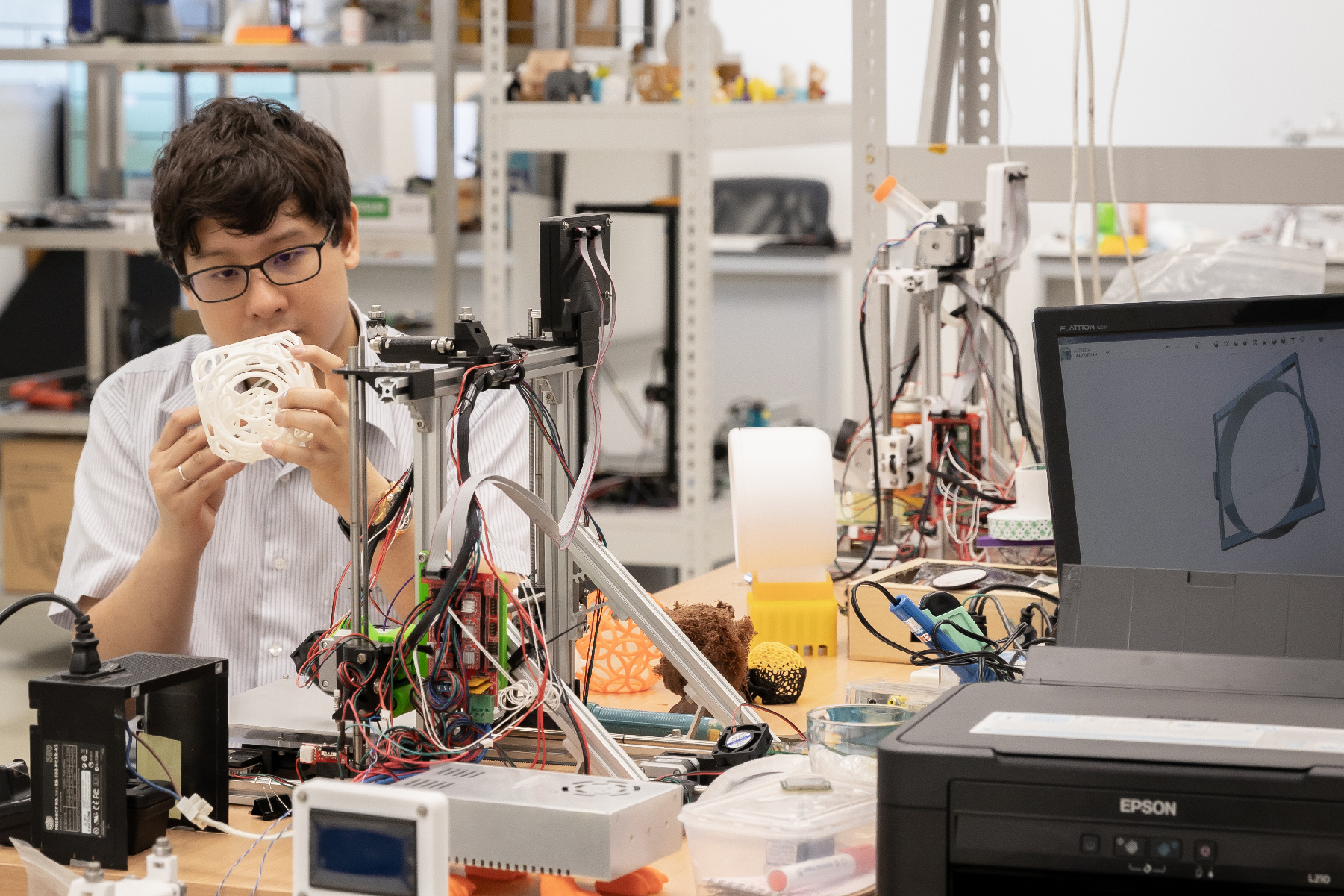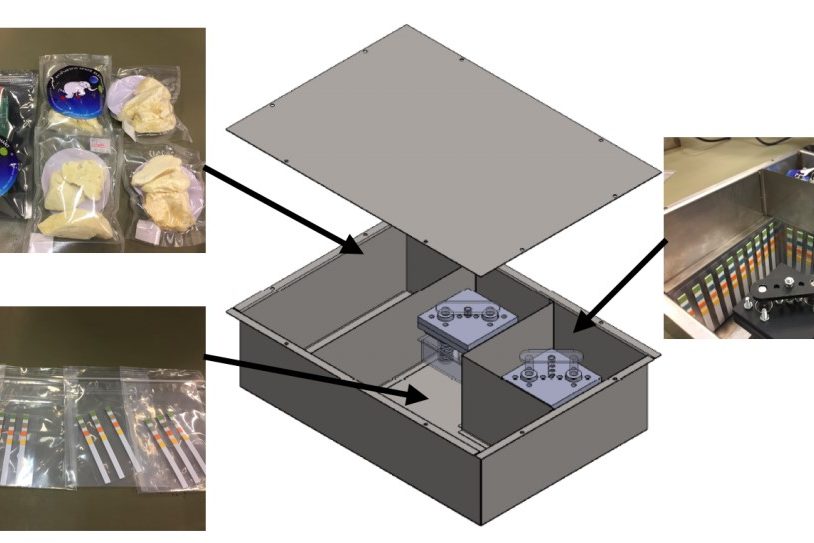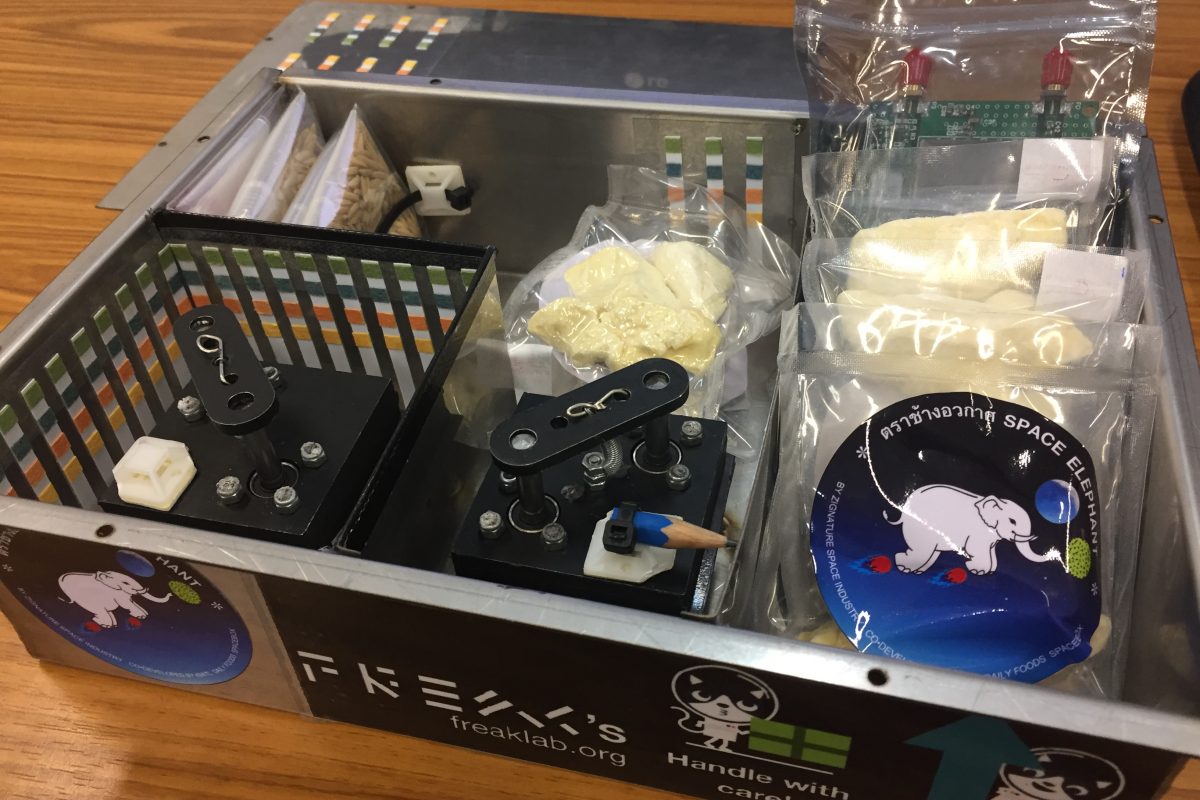ART4D SIT DOWN AND HAVE A CONVERSATION WITH THE MINDS BEHIND FREAK LAB, AN ‘ANTI-DISCIPLINE’ RESEARCH CLUSTER THAT AIMS TO MERGE THE RELATIONSHIP BETWEEN SCIENCE, TECHNOLOGY, ART, AND HUMAN
TEXT: RAWIRUJ SURADIN
PORTRAIT: KETSIREE WONGWAN
PHOTO: KETSIREE WONGWAN EXCEPT AS NOTED
(For English, please scroll down)
หากกล่าวว่ารากฐานของ FREAK Lab อยู่ในพื้นที่แล็บของมหาวิทยาลัยเทคโนโลยีพระจอมเกล้าธนบุรีก็อาจจะไม่ถูกนัก เพราะเราได้รับการบอกกล่าวอยู่หลายครั้งว่า FREAK Lab เป็นการรวมตัวของกลุ่มคนมากกว่าความเป็นแล็บในเชิงกายภาพ “คนเริ่มต้นคือ รศ.ดร.วีระศักดิ์ สุระเรืองชัย เป็นอาจารย์อยู่ที่บางมด (มหาวิทยาลัยเทคโนโลยีพระจอมเกล้าธนบุรี) และพีพี (พัทน์ ภัทรนุธาพร) รวมถึงเหล่าศิษย์เก่าของโครงการพัฒนาอัจฉริยภาพทางวิทยาศาสตร์สำหรับเด็กและเยาวชน (JSTP) เราเลยใช้พื้นที่ที่บางมดเป็นหลัก แต่พอเริ่มมีคนอื่นๆ เข้ามา อย่างเช่นอาจารย์ที่อยู่มหาวิทยาลัยอื่น เราก็เลยสามารถไปใช้ห้องทดลองหรือเครื่องมือของเขาที่อยู่ที่อื่นได้” โพธิวัฒน์ งามขจรวิวัฒน์ ผู้จัดการแล็บกล่าว พร้อมเสริมว่าการที่คนมาเข้าร่วมเป็นสมาชิกทำงานร่วมกับ FREAK Lab เกิดจากความสนใจในการสร้างสรรค์ใหม่ที่แตกต่าง มากกว่าจุดร่วมทางด้านอาชีพหรือการศึกษา สมาชิกในทีมจึงมีทั้งนักวิทยาศาสตร์ วิศวกร ศิลปิน นักเขียน ฯลฯ “ตอนนี้เราแบ่งเป็นกลุ่มใหญ่ๆ อย่างกลุ่ม Unschooling กลุ่ม Neuro Media คือเรามีเป็นกลุ่มก็จริง แต่ไม่ได้หมายความว่านี่คือกลุ่มของใคร เราสนใจมากกว่าว่างานที่เราจะทำมันเจ๋งไหม เจ๋งยังไง แล้วใครจะทำบ้าง ใครจะมาซัพพอร์ตใครจากตรงไหนบ้าง แบบนั้นมากกว่า”

วเรศ จันทร์เจริญ ผู้นำกลุ่มวิจัยอวกาศของ FREAK Lab / Wares Chancharoen, leader of Freak Lab’s C.A.T Space research group.
เมื่อถามถึงมุมมองต่อวิทยาศาสตร์และศาสตร์อื่นๆ โพธิวัฒน์ย้ำอยู่เสมอว่าคำตอบของเขาเป็นเพียงความเห็นส่วนตัว และทุกคนในทีมก็มีความเห็นต่างกัน ซึ่งการมารวมตัวของความคิดเห็นที่แตกต่างนี้เองที่ทำให้ทีม FREAK Lab มองเห็นอนาคตที่ต่างออกไป เพราะอนาคตของพวกเขาถูกมองจากหลายมุม จุดเด่นนี้เองที่ทำให้ FREAK Lab แตกต่างจากกลุ่มนักสร้างสรรค์อื่นๆ รวมถึงแนวคิดแบบ anti-disciplinary ซึ่งมองข้ามกรอบคิดของแต่ละสาขาวิชา ทำให้เกิดความเป็นไปได้ที่มากกว่าการพัฒนาความรู้ในเชิงลึกเพียงด้านเดียว “พอเราไม่พูดถึง discipline เวลาเราคิดโปรเจ็คต์อะไรออกมา มันจะไม่โดนจำกัดขอบเขตด้วยสิ่งที่เรารู้อยู่แล้ว สมมุติว่าเราเชี่ยวชาญทางด้านเครื่องกล แล้วเราก็จะคิดแต่โปรเจ็คต์ที่มีพื้นฐานมาจากสิ่งที่ตัวเองรู้ เราเชี่ยวชาญด้านไหนเราก็อยากทำแบบนั้น มันก็จะไม่ได้สิ่งที่แปลกใหม่ไปจากเดิมเท่าไหร่ มันแค่ develop ไม่ใช่ disrupt” มุมมองจากวเรศ จันทร์เจริญ ผู้นำกลุ่มวิจัยอวกาศของ FREAK Lab
วิธีคิดและมุมมองเหล่านั้นนำมาสู่ผลงานที่น่าสนใจอย่างเช่น การร่วมมือกับ mu Space Corp บริษัทด้านเทคโนโลยีอวกาศของไทย ในการส่งทุเรียนขึ้นไปกับยานอวกาศของ Blue Origin บริษัทผู้ผลิตยานอวกาศและให้บริการด้านอวกาศจากสหรัฐอเมริกา เพื่อทดสอบบรรจุภัณฑ์ของไทยเรื่องการรั่วไหล โจทย์ที่ท้าทายคือการไม่มีระบบไฟฟ้าและอิเล็กทรอนิกส์ภายในบริเวณห้องโดยสารซึ่งเป็นพื้นที่ทดลองในยานอวกาศนี้ และทางออกคือการคิดระบบเชิงกลที่ทำงานในสภาวะไร้แรงโน้มถ่วง โปรเจ็คต์ Emoti-Khon ซึ่งผสานการใช้เทคโนโลยี facial recognition เข้ากับเนื้อหาเชิงวัฒนธรรมอย่างตัวละครโขน โดยการแสดงผลสัมพันธ์กับอารมณ์ของผู้คนที่เดินผ่านไปมาซึ่งคอมพิวเตอร์ตรวจจับได้ ไปจนถึงโปรเจ็คต์การสร้างอาหารขึ้นมาจากเทคโนโลยีการพิมพ์สามมิติ
ทุเรียนที่ส่งขึ้นไปกับยานอวกาศของ Blue Origin เพื่อทดสอบเรื่องการรั่วไหลของบรรจุภัณฑ์ / Space durians that sent with the Blue Origin, to test the leakage of Thai-made package. © FREAK Lab
ในขณะที่วิทยาศาสตร์สร้างสรรค์ผลงานที่เป็นรูปธรรม การทดลองและสำรวจของวิธีคิดแบบวิทยาศาสตร์ยังนำมาซึ่งการทำความเข้าใจและตีความความจริง (reality) ด้วยวิธีการที่ดูเป็นวัตถุวิสัย (objective) แต่หลายครั้งที่ความจริงผ่านสายตาของนักวิทยาศาสตร์นั้นถูกมองด้วยทฤษฎีที่ต่างกันอย่างชัดเจน อย่างการคัดง้างระหว่างทฤษฎีสัมพันธภาพ (Relativity) และกลศาสตร์ควอนตัม (Quantum Mechanics) หรือความขัดแย้งระหว่างทฤษฎีสภาวะคงที่ (Steady State) และทฤษฎีการระเบิดครั้งใหญ่ (Big Bang) “ความจริงมันคือความจริงนั่นแหละ อยู่ที่ว่าเรามองมันในเงื่อนไขไหน แบบไหน และด้วยเงื่อนไขนั้น มันส่งผลต่อคำตอบอย่างไร เช่น ในคำถามจิตวิทยาที่บอกว่ามีรถไฟวิ่งมา แล้วเราต้องเลือกสับรางไปทางซ้ายหรือทางขวา ทางซ้ายคือลูกเราคนเดียว ทางขวาคือเด็กที่ไม่รู้จักห้าคน คำถามคือเราจะเลือกอะไร คือยังไงก็ต้องมีการตายเกิดขึ้น บางคนอาจบอกว่าเอาลูกเราไว้ก่อน ลูกเราสำคัญที่สุด นั่นก็คือความจริง บางคนอาจบอกว่าเอาจำนวนของชีวิตคนไว้ก่อนดีกว่า งั้นเราก็ต้องยอมเสียลูก เพื่อให้คนจำนวนที่เยอะกว่ารอด นั่นก็คือความจริงอีกแบบหนึ่ง” โพธิวัฒน์กล่าว
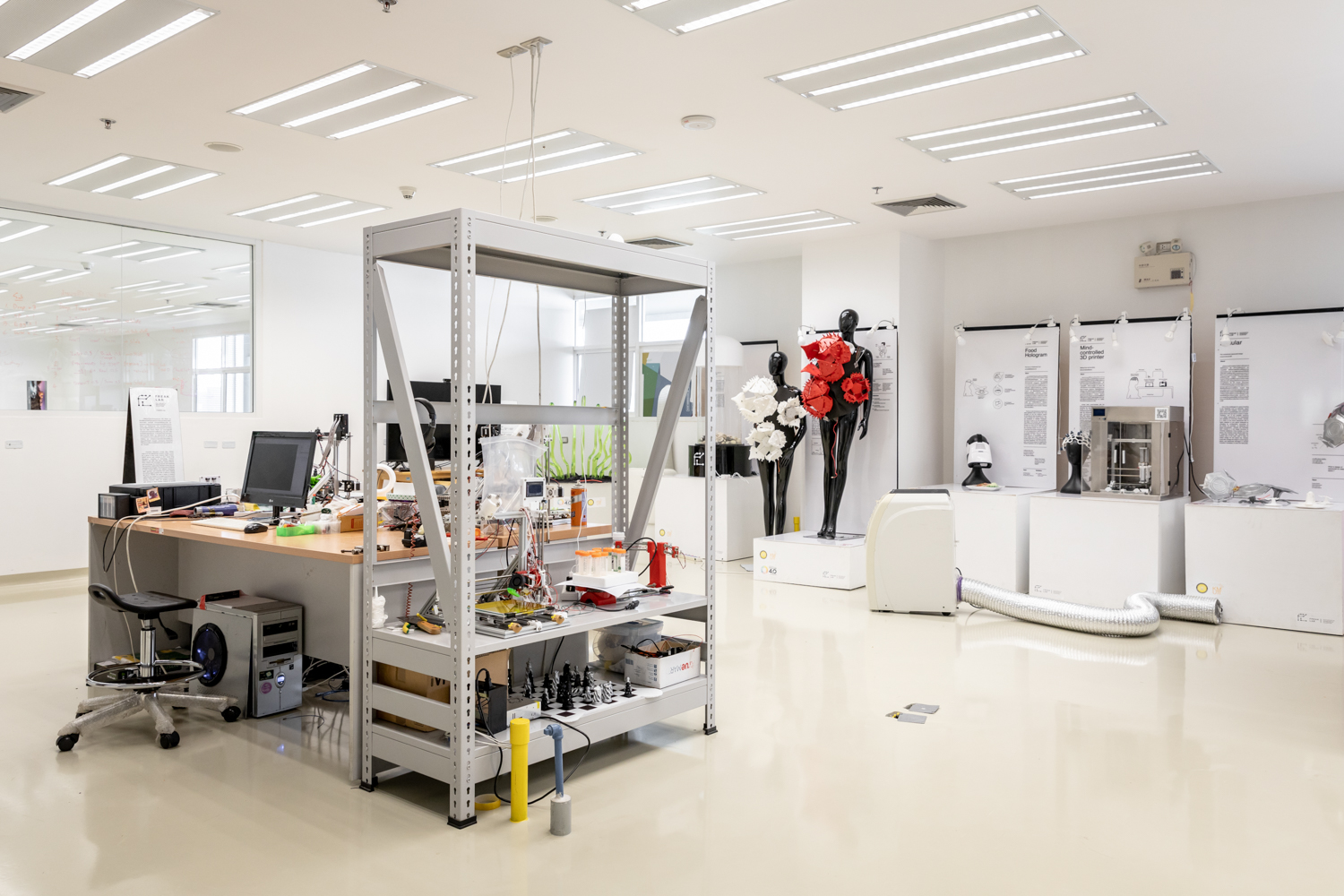
เมื่อถามถึงเส้นแบ่งระหว่างศิลปะและวิทยาศาสตร์ โพธิวัฒน์ให้ความเห็นว่า “วิทยาศาสตร์มันอาจจะดูคมเพราะมันเป็น 0 กับ 1 เป็น logic ที่พอเวลาเราคิดจะต้องเป็นใช่กับไม่ใช่ แต่พอเป็นศิลปะมันมีคำว่า ‘น่าจะ’ มันจะเทาๆ ไม่ใช่ขาวหรือดำไปเลย มันต่างกันอยู่แค่นั้น ความต่างนี้ทำให้เรารู้สึกถึงความโค้งมนของศิลปะ ส่วนตัวไม่อยากให้แบ่งว่าเป็น 0 กับ 1 แต่คนส่วนใหญ่จะเห็นภาพแบบนั้น ว่าวิทยาศาสตร์เป็น 0 กับ 1 แต่จริงๆ แล้ววิทยาศาสตร์มันก็มีความเทาๆ เหมือนกัน” ก่อนที่วเรศจะเสริมว่าการแบ่งแยกระหว่างวิทยาศาตร์กับศิลปะนั้น ค่อนข้างมีความชัดเจนเป็นอย่างมากในสังคมไทย “ในข่าวประเทศอื่นไม่ค่อยใช้คำว่า scientifically อะไรพวกนี้เลย อย่างญี่ปุ่นก็ไม่มี เขาจะอธิบายทุกเรื่องให้มันเป็น nature หมด แล้วด้วยความที่มันเป็น nature มันก็คือวิทยาศาสตร์อยู่แล้ว แม้แต่เรื่องของศิลปะเองก็ด้วย เพราะจริงๆ แล้ว ศิลปะ ก็คือ nature คือวิทยาศาสตร์ตัวเดียวกัน ซึ่งมันทำให้คนซึมซับวิทยาศาสตร์ในมุมมองปกติของชีวิตไปเลย เวลาผู้ปกครองเขาสอนลูก เขาก็จะสอนในบริบทของ nature แล้วเด็กก็จะซึมซับความเป็น nature ที่มีวิทยาศาสตร์อยู่ในนั้นแล้วไปพร้อมกัน”

To say that the foundation and operation FREAK Lab evolves from King Mongkut’s University of Technology Thonburi or KMUTT’s laboratory would be a bit misleading. The truth of the matter is we have been told many times that FREAK Lab is more of a collective of open-minded people rather than physical laboratory operations. “The initial founder is Dr. Werasak Surareungchai, who is a KMUTT professor, and PP (Pat Pataranutaporn), including the alumni of JSTP (Junior Science Talent Project), which is why we used primarily KMUTT Bangmod’s facility as our operation ground. But once we are joined by professors from other universities, we have been able to use their labs and tools as well.” Potiwat Ngamkajornwiwat, the lab’s manager explains, before adding that more people have been attracting to FREAK Lab because their interest in their diverse approaches and possibilities they have for creativity, which go beyond professional or educational common ground. The members of the team range from scientists, engineers to artists and writers, etc. “We have a number of research groups such as Unschooling and Neuro Media, but it doesn’t necessarily mean that it’s a specific group for a certain group of people’s. We’re more about coming up with a cool project and finding the best way to execute it, finding the persons who would be suitable for or interested in joining and supporting it. It’s more that way.”
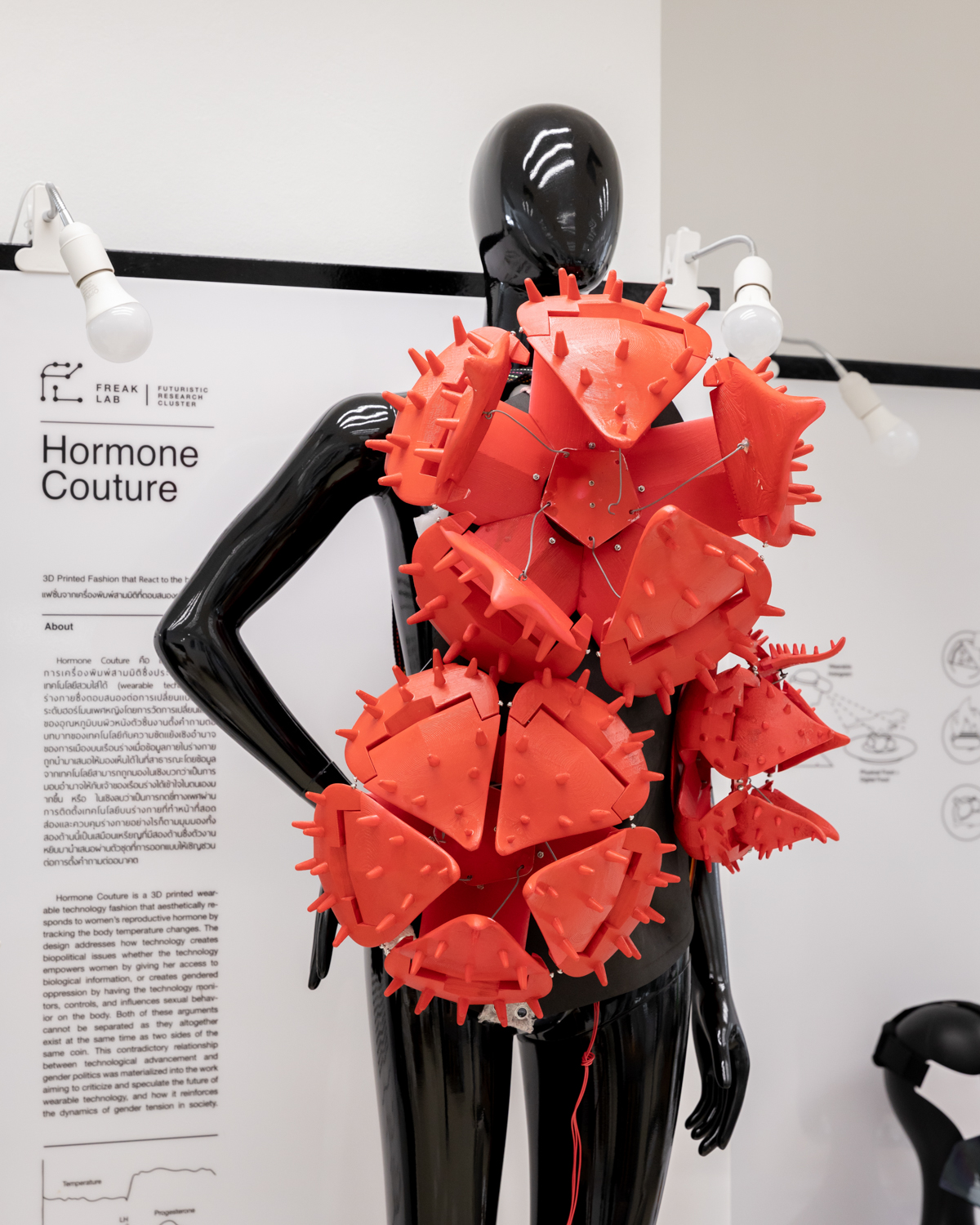
Hormone Couture เครื่องแต่งกายจากเครื่องพิมพ์สามมิติ ที่ตอบสนองต่อระดับฮอร์โมนของร่างกายสตรีที่สวมใส่ / “Hormone Couture”, a 3D printed wearable technology fashion that aesthetically responds to women’s reproductive hormone by tracking the body temperature changes.
When we asked about his point of view on science and other fields of study, Ngamkajornwiwat constantly emphasizes that his answer is entirely his personal sentiment and everyone in the team possesses different opinions. Such convergence of ideas enables FREAK Lab to envision a different future; the one that is viewed and approached from incredibly diverse trajectories. This distinctive nature is what differentiates FREAK Lab from other creative collectives. Their anti-disciplinary approach stretches beyond conceptual frameworks, enabling other possibilities greater than the in-depth theoretical development. “When discipline is made absent, a project is not limited by the boundary of what we already know. For example, if our expertise is in the mechanical system, naturally we tend to develop a project based on our knowledge; what we know best. We want to do things using our expertise, but the rendered outcome wouldn’t be that much of a difference. It’s developed but not disrupted,” said Wares Chancharoen, leader of Freak Lab’s C.A.T Space research group.
Emoti-Khon © Freak Lab
These thought processes and perceptions have lead them to some very interesting works such as the collaboration with mu Space Corp, a Thai company specializing in space technology, in sending durians up to the space on the New Shepard rocket belonging to Blue Origin, a US space flight company, to test the leakage of Thai-made packaging. The challenge is the absence of electrical system and electronic system inside the cabin, which is used as the experimental ground in the outer space, and the solution is to come up with a mechanical system that can be operated within the zero-gravity environment. Other projects are such as Emoti-Khon, the project that integrates facial recognition technology to the cultural content of “Khon” characters where the processed and displayed data is the result of the detected emotions of people walking past a computer-operated system, as well as the use of 3D printing technology to produce food.
While science creates tangible final outcomes, experiments and explorations done based on scientific thinking leads to one’s objective understanding and interpretation of reality. Nevertheless, there are times when the reality projected through the eyes of scientists is being perceived from different theories be there Relativity, Quantum Mechanics to Steady State and Big Bang. “Reality is a reality. It may vary according to different conditions we see it with; how we look it, and how such conditions affect the answer. For example, a psychological question about a train coming and you’re forced to choose between switching the rail to the left, which is the direction where your own child is or to the right where there are five children you’ve never known before. The real question here is what will you choose? Someone is going to die and that’s inescapable. Some people choose to save their own kid because that’s the most important thing to them and that’s the reality. Some people choose five kids because more lives can be saved instead of one but you end up losing your own child in order for more people to survive. And that’s another reality,” Ngamkajornwiwat shares his observation.
โปรเจ็คต์ Immersive Ayutthaya ที่นำเทคโนโลยี AR เข้ามาใช้ในการสร้างสรรค์ธุรกิจเชิงท่องเที่ยว / Immersive Ayutthaya is another project from FREAK Lab, which is using Augmented Reality technology to create a creative business. © FREAK Lab
Ngamkajornwiwat also has an interesting view on the line between art and science, “Science is sharp and solid because it’s 0 and 1. It’s logic. It’s about right and wrong. But with art, there’s the probability. There’s a gray area instead of just black or white. That’s the difference. And such difference allows us to sense that art is non-linear. I personally don’t want everyone to think of science as 0 and 1. Science does have a gray area.” Chancharoen then added that the division between art and science is highly obvious in Thai society. “The word ‘scientifically’ is rarely used in the news in counties such as Japan where everything is explained as nature. Science in itself is nature. Even art is nature. It’s all the same thing. It makes people assimilate science as a part of their daily life. When parents teach their kids, they do it within the context of nature, and the children learn about nature as something that science is apart of, and everything goes hand in hand from there.”

